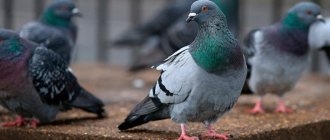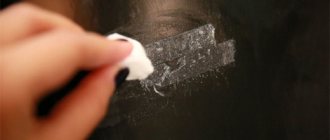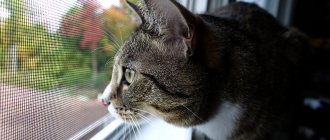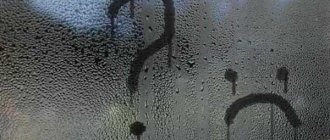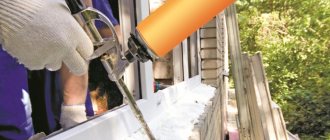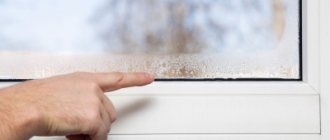Author: Michael Potter Updated: March 22, 2020
Thanks to their unpretentiousness, pigeons (Columba livia) have become an integral part of the urban environment. They have successfully settled literally everywhere: on farms and elevators, in parks and city squares, under engineering structures and near bird feeders. Some compare pigeons to “flying rats,” and even quite peace-loving citizens think about using poison against these pests. In this review, we will tell you how to get rid of pigeons for a long time, what scientists advise, and whether it is really worth using toxicants. Then, based on the opinions of professionals and customer reviews, we will present the top best repellers: mesh, spikes, electric fence, water repeller with motion sensor and chemical repellent gels.
Why are pigeons dangerous?
The presence of a flock produces a large amount of droppings, which is not only unsightly, but also harmful - plants die, metal rusts. At agricultural enterprises, pigeons can heavily contaminate grain. In addition, pigeons are carriers of serious diseases (ornithosis, encephalitis, salmonellosis). However, scientists from the University of Missouri consider the likelihood of human infection to be low.
However, few people know that a thick layer of pigeon droppings on the eaves is a source of fungal infection. Histoplasmosis affects a person's lungs and sometimes leads to death.
Obviously, the excessive importunity of pigeons needs to be combated. At the very least, you shouldn’t feed them on the balcony, as some city dwellers do. To avoid nesting, do not leave trash or old furniture in areas accessible to birds. Farmers need to take care to properly store grain and, if possible, make it difficult for birds to access water.
Video examples of successful problem solving
Homemade repellers:
Anti-landing strips:
Stuffed Crow:
It will take a lot of time and patience to drive pigeons off your balcony. But the opportunity to carry flowers there without fear, walk on a clean floor, and store what your heart desires is worth it. And remember: if you are tired of fighting, you can always just glaze the balcony.
YOU MAY ALSO BE INTERESTED
How to get rid of pigeons on the balcony, eaves and in the garden
It is not so difficult to prevent pigeons from nesting, although they are capable of taking a liking to any recess or cavity. Try to make all such parts of the building - attic windows, ventilation hatches, cornices, window sills - inconvenient for birds to land on.
A mesh with ¼-inch holes made of stainless wire, plastic or nylon is suitable for this UV-resistant polypropylene mesh with one-inch holes will help protect architectural elements. It is best to buy mesh in a universal black color or paint it to match the color of the building. The method is not only effective, but also durable: such a barrier will last about 10 years.
In outbuildings, netting is attached to the bottom of the rafters to prevent birds from establishing themselves inside. If necessary, “doors” are made in the material - slots with Velcro. It's also a good idea to hang a curtain made of plastic tape at the entrance.
You can permanently get rid of pigeons looking into windows by changing the angle of the cornice by 45 degrees or more. Now on sale there are special polycarbonate plates that are suitable for any “L”-shaped protrusions. The plates can be glued or screwed to any surface. Such an engineering design simply will not allow birds to land on the building.
Another option is to buy special spikes made of plastic or stainless steel. Their sharp teeth are an insurmountable barrier for almost all types of birds. The spikes are as universal as the nets, because they are attached to any surface (due to their own design or glue). To prevent the spikes from losing their properties, they need to be cleaned from time to time.
If you think that meshes and spikes do not look aesthetically pleasing, use stainless wire . The wire is stretched between metal posts, which are sold in the same set with the coil, and is slightly springy. The minimalism of the design makes it appropriate even on railings and facades of ancient buildings.
Among the physical barriers, experts also mention electrical bird control systems . The device is an electrical cable with a control unit.
When pigeons come into contact with conductors and cables, they receive an electric shock that repels but does not kill them. The cable can be installed in the same place where bird spikes, steel wire or fishing line are installed. Although electrical devices and their installation are typically labor-intensive and/or costly, their efficiency in some cases is worth the investment, say David E. Williams and Robert M. Corrigan.
The service life of such a device is about 8 years. Despite the guarantee of safety, the device is more suitable for uninhabited places, such as rooftops or industrial sites.
To summarize, physical barriers are the most effective method for eliminating pigeons.
Visual and audio aids
Pigeons are by no means forest birds, so they cannot be frightened by either loud noise or reflectors. It would be tempting to use ultrasonic devices, but they do not inspire confidence among scientists. In the case of pigeons, you shouldn’t spend money on predator figurines or speaker systems, experts say.
Chemical repellents
Pigeon repellents are attractive due to their low price (some products cost ~$8) and ease of use: you just need to squeeze a tube onto the eaves. Many users actually got rid of pests this way, but there are also those who were dissatisfied. This is because chemicals are not without their drawbacks.
The main one is the potential threat to animals, even if the product is not toxic. Most common sticky repellents can gum up a bird's plumage and prevent it from flying. This is especially dangerous for small species, which sometimes accidentally fall into a “sticky trap” prepared for pigeons.
In addition, over time, debris sticks to the treated surface, so the birds no longer experience discomfort from contact with the sticky environment. However, some manufacturers have taken this nuance into account: when exposed to air, the gel becomes covered with a protective crust, which prolongs its effect. One application is enough for a whole year.
Dried repellent does not clean well and leaves stains, and it must be applied thickly: the distance between strips should not exceed 3-4 inches. Before using the product, it is recommended to protect the surface with waterproof tape or plastic.
In non-residential premises, it is permissible to use naphthalene (not to be confused with paradichlorobenzene) to repel pigeons. A strong chemical smell will force the flock to leave the area. For every 2,000 cubic feet of area, 5 pounds of chemical is required. After the birds have flown away, you need to close all existing holes so that the pigeons do not return. Remember that mothballs are hazardous to health, especially when it comes to allergy sufferers.
Getting rid of birds: what scientists suggest
Each species has different characteristics of behavior and life activity. Therefore, the combinations of control methods both for different types of buildings and against different species are different. It is also important to have several methods of fighting in your arsenal, since birds get used to most methods over time.
The key to using repellers effectively is to start using them as quickly as possible, immediately after a problem is discovered (or even earlier if there is such a danger), so that the animals do not become accustomed to the area. It is also important to use sufficiently aggressive repellent methods to prevent animals from becoming accustomed to the devices. And lastly, it is most effective to use methods of influencing several senses at once so that the pest does not leave a feeling of anxiety and caution, says Holly K. Ober from the University of Florida.
Preventive measures: avoiding a problem is easier than fighting it
Compliance with certain rules when running a household or maintaining retail space will help avoid interest in it from birds. In grain barns it is recommended to use bird-proof storage facilities, on livestock farms - special drinkers and feeders and to maintain order.
At the entrances to retail facilities, it is necessary to hang plastic strips that completely cover the opening from birds, allowing people with heavy bags and carts to move around. Also block ventilation and other entrances to the room, insulate rafter structures and repair windows.
What Birds Are Afraid of: A Review of the 7 Best Methods
If it is not possible to completely eliminate birds or it is not economically feasible, try reducing the attractiveness of bird roosting and nesting sites. These methods are safe for people, livestock and non-target animals, but often require large amounts of money and time to set up, according to the Pennsylvania State College of Agricultural Sciences.
To counteract the arrival or nesting, various physical barriers , such as spikes on the eaves, nets that protect garden crops from being eaten, and changing the slope of the eaves and window sills. Spikes and mesh will help in the fight against pigeons and larger birds, but small species will be able to settle between the spikes or crawl into a mesh cell. Also, plants or other attractive places and objects can be treated with a spray or gel that has an unpleasant odor or irritates their mucous membranes. Having received a negative experience, a flock or an individual will decide to leave the place.
To get rid of all types of birds, scientists advise resorting to repellent methods , and it is advisable to alternate or combine them. The simplest option is to use dummies and scarecrows in the form of birds of prey or even in the form of eyes . Scientists approve of the use of reflective devices: tapes, slats, discs. This method is considered one of the most common. But there are nuances: pests quickly get used to such objects. And in windless, gloomy weather, when the reflectors do not swing or make noise, they are of little use.
Stores also sell electronic repellents . Some - acoustic - act on the ear. Another type is water repellers with a motion sensor, which release a stream of water towards the trespasser. If the method with water is not in doubt, then with ultrasound the question is not so clear. Despite the fact that there are also positive reviews of such repellers, there are still more negative ones. And scientists doubt their effectiveness as an independent method. Thus, experts from the University of Nebraska-Lincoln state: “Acoustic devices themselves are ineffective against birds or effective only for a short time. To be useful in such a matter, acoustic devices must be used in conjunction with other monitoring methods. Their most effective use is possible when additional measures are applied that lead to death or painful experience of some members of the population or flock...”
Among other repellents that affect hearing, scientists highlight programmable sound repellers. They record the voices of birds of prey that scare away different types of birds. Such devices can even be configured to scare off specific species: pigeons, sparrows, etc.
Chemical methods
Chemical compounds are used not only to scare away birds, but also to “confuse” them. For this purpose, substances with tannins that interfere with rapid digestion are used, viscous and sticky compounds that complicate food consumption, or masking substances that make fruits or grains invisible. Based on the principle of action on the body, Michael L. Avery from the University of Nebraska divides compounds into two categories:
“Primary repellents cause pain or irritation on contact, and the bird reacts reflexively without expecting a response. Extensive research into the nature and characteristics of dozens of primary repellents leads researchers to the conclusion that pain or irritation resulting from such contact provokes an avoidance response in birds. Many of these compounds have ecological significance in the interaction between birds and their natural foods, and one of the primary repellent compounds, methyl anthranilate, is a registered bird deterrent. Many primary repellents are toxic, but because these compounds taste disgusting, birds will not be able to ingest enough of it to actually harm them. Secondary repellents do not have a distinctly unpleasant taste, but cause illness or discomfort after ingestion.”
The use of primary or secondary repellent is determined by the lifestyle of the bird. If she lives nearby, a secondary repellent is preferable. A primary repellent is suitable for nomadic species.
One such irritant is methyl anthranilate (MA), which is used in the food industry and is safe for humans. It acts on the nervous system as an irritant, causing the bird to lose its appetite. This drug is used to protect berry crops and control the behavior of geese. Anthraquinone, a secondary repellent that causes digestive discomfort, is sometimes used to protect seeds and turf. Subsequently, the individual develops a dislike for foods similar to processed ones.
Another secondary action substance is methiocarb, which is designed against insects. For birds, the compound is not fatal and only causes vomiting and temporary paralysis. However, the substance is toxic and requires the correct dosage so as not to kill the birds. Among non-core compounds, it is also worth noting fungicides that inhibit the activity of birds.
Nest destruction: how to get rid of a bird's nest
Methods to reduce reproduction are permitted for some non-protected species, most notably sparrows, pigeons and starlings. Penn State College of Agricultural Sciences professor of Wildlife Resources Margaret C. Brittingham recommends making a long stick with a hook that can be used to periodically destroy nests. A more labor-intensive and delicate way is to get to the nest and pierce the eggs with a pin. Since the birds will still hatch them, they will not start building new nests and laying new eggs.
Setting up traps
Bird traps are designed in such a way that they are not harmed and are subsequently released.
Lethal methods
There are very few species that are not protected in any way at the regional, state or international level. These are common pigeons, house sparrows and starlings. They are allowed to be hunted and shot where shooting is generally permitted.
It is important to note that when using lethal methods, it is necessary to monitor the impact on non-target and protected species and limit the possibility of impacting them as much as possible.
Comparison table of methods and repellers
| Method/product | How, when and where to use it best | Benefits of exposure | Minuses |
| Grids | For the protection of attic windows, ventilation hatches, cornices, window sills, flower beds and beds | Affordable, durable, versatile | Not very aesthetically pleasing |
| Spikes | On the eaves of houses and city fences | Prevents pests from landing on surfaces | Not very aesthetically pleasing. Needs to be cleaned periodically. |
| Wire | On the eaves of houses, railings, fences, roofs, facades | Effectively repels birds. More appropriate and aesthetically pleasing than spikes | Periodically you need to check the integrity of the tension wire |
| Electrical Bird Control Systems | To protect any areas and surfaces attacked by pigeons | Durable: service life -8 years. Does not kill, but only scares away birds | Expensive. More suitable for deserted places: roofs, industrial sites. |
| Chemical repellents: gels, sprays, naphthalene | Various surfaces are processed: cornices, roofs, railings, lawns, monuments, etc. | Causes a persistent reflex that forces you to avoid treated areas in the future | Some compounds are toxic and require proper use according to instructions. |
Chemical repellents
When deciding how to keep pigeons away from your home, you can opt for chemical repellents. It is advisable to use relatively safe means:
- sticky substances - they glue paws, glue feathers, which makes birds refuse to visit “dangerous” places;
- non-toxic repellents based on strong-smelling substances (essential oils, menthol, capsaicin) with an unpleasant taste - they do not lead to poisoning (preparations with such properties can be found in the assortment of Pestman or other manufacturers).
Such means have their drawbacks. Sticky substances accumulate dirt over time, lose effectiveness, and spoil the appearance of eaves, window sills, and ebbs. If a small bird lands on the trap, it may subsequently die due to feathers sticking together and the inability to fly normally. It is difficult to clean surfaces from frozen substances. Strong-smelling substances should not be used in closed spaces if there are people present. In open areas they lose effectiveness over time.
TOP 8 pigeon repellers
Based on the opinions of experts, we have selected the most diverse means so that you can choose the most suitable one for your situation: mesh, spikes, electric fence, water repeller with a motion sensor and chemical repellent gels.
Bird repellent gel
If you don’t want to spoil the view from your window with a metal picket fence on the eaves, try “liquid spikes.” Theoretically, this gel can be used anywhere, but you should not apply it to the railings or sides of the pool - the surface will become very sticky. In addition, the transparent repellent darkens from dirt and dust, so it cannot be called invisible. However, the gel is non-toxic and is relatively easy to wash off. One tube will last for a long time. Judging by the description, it is enough to use the product once every six months - provided that you live in a temperate climate.
Price: 2200 rub.
Bird net
Sometimes simple but time-tested devices are more powerful than new ones. A number of users note that they got rid of pigeons on the balcony thanks to a regular mesh, which was secured to metal brackets. The polypropylene mesh is UV resistant and will last for many years. It can also be used to cover ridges and fruit trees (just be sure to secure the edges, otherwise the birds may get confused). The mesh is sold in rolls - the larger the size, the higher the price.
Price: 220 rub.
Spikes
The best protection against pigeons in the city is physical barriers. Moreover, some structures can be installed even by a child. For example, plastic spikes can simply be glued to the cornice. Popular spikes are made of polycarbonate and stainless steel. The price depends on the material and length of the product. Plastic spikes create a more frequent fence, but they are also more fragile, so it is better to use metal ones against arrogant pests. Metal spikes are attached even to uneven surfaces due to the flexible base. To protect fences and gates, you can buy a set of propylene studded strips 10 x 48.8 cm.
Price: 170 rub.
Fi-Shock EAC10A-FS Super 525 Energizer, 10-Acre
Above, we mentioned electrical control systems as the means recommended by scientists. You can find an electric fence from Fi-Shock. This device creates an electric fence for small pets like rabbits and chickens. However, judging by the reviews, it can also be adapted to protect the territory from pigeons. “I have two of these devices. In the countryside I use one fence to keep animals away from the wood decking and railings. In the city, another helps keep pigeons from encroaching on the railings,” writes user Lux Occultus. True, the manufacturer itself does not indicate that the device is effective against pigeons. In addition, the wire will have to be purchased separately.
Price: ~$29.99.
Orbit 62100 Yard Enforcer Motion Activated Sprinkler with Day and Night Detection Modes
A water repeller with a motion sensor is ideal for protecting your lawn or outdoor pool. The sprinkler has a 120-degree motion sensor, which works even in the dark and repels not only birds, but also small animals. If an intruder gets closer than 35 feet, the device releases a stream of water. It can also be set to water for 30 minutes. The sprayer runs on 4 batteries and has almost no complaints about the quality.
Price: ~$45.30.
Bird-X Bird Stop Liquid Deterrent
The repellent is based on methyl anthranilate, a safe component that is found in small doses in essential oils and cosmetic products. Bird Stop is a concentrate of this substance and therefore has a pungent odor and unpleasant taste. In accordance with the instructions, the repellent must be diluted with water and sprayed in an open area: in the garden, on the lawn, on the roof, on the surface of the siding or near vegetable plantings. The manufacturer claims that Bird Stop repels all common bird species, including pigeons. However, there are a lot of negative reviews: users write that the spray does not work against geese, for example. And in this case, a large volume of product (1 gallon) is more a minus than a plus. However, Bird Stop can be recommended for use in rural areas where there are not as many pigeons as other pest birds. It is a humane alternative compared to toxic agents.
Price: ~$91.48.
A mild measure of influence - deterrents
To prevent pigeons from flying up to the windows and settling on the balcony, it is enough to scare them away for a certain time, and the birds will consider that they have chosen a place that is not safe enough. If the house is located in a windy area, the simplest solution is homemade propellers made of bright glossy film. As they rotate, they emit a peculiar crackling and humming sound. You just need to secure a few on the balcony railing or window sill.
Another option in case there is little air movement is a tape from a tape cassette. Tied in short lengths to a stretched twine or clothesline, or twisted in bundles and secured to a driven nail, narrow strips of film rustle quite loudly, and even sway even in a weak wind. Pigeons usually don’t like this kind of proximity and prefer to stay away. Foil strips give the best effect, but they are short-lived.
The best solution is considered to be broken, unreadable DVD discs, which sparkle in the sun and rotate in the wind, and if you hang several nearby, they also make loud noises. Such pendants will last quite a long time; they can scare away birds for several years without losing much of their properties, especially if you periodically wipe the glossy side from dust.
To scare away pigeons, you can hang a “wind chime” from Feng Shui talismans on the balcony; ringing, swinging slats or tubes can become a source of sounds that are unpleasant for birds.
Comparison table of the best pigeon repellers
| Name | Type | How to use | Price |
| Bird repellent gel | Chemical repellents | “Liquid nails”, leave a strip on the eaves, roof | 2200 rub. |
| Net | Net | As a barrier - fix it on the balcony, cover the beds, etc. | 220 rub. |
| Anti-landing spikes | Spikes | For protecting fences and gates | 170 rub. |
| Fi-Shock EAC10A-FS Super 525 Energizer | Electric fence | As a barrier in areas where birds are active | ~$29.99. |
| Orbit 62100 Yard Enforcer Motion Activated Sprinkler | Water repeller with motion sensor | Connect to water and install on a personal plot, positioned opposite the protected object | $45.30 |
| Bird-X Liquid Deterrent | Chemical repellents | Dilute with water and spray on open areas: lawns, roofs, lawns, etc. | $91.48 |
Poison for pigeons: is it worth using?
The most radical way to combat pests is physical destruction. However, before acting, it is necessary to clarify two issues: legal and sanitary-hygienic. Although pigeons are not a protected species, check your state's laws. If there is no ban on killing pigeons, you need to decide how to do it safely.
It may be worth contacting a specialist service, as toxicants registered for pigeon control are only available to professionals. For example, the DRC-1339 tool may only be used by USDA APHIS-Wildlife Services employees or persons working under its supervision. Avitrol, one of the most effective pesticides, is also limited in use.
– In order to obtain approval for Avitrol, you must adequately describe in your application how you will protect “non-target” birds from accidental poisoning. Be prepared to scare away all such birds that come to feed, even if you scare away the pigeons along with them. Their protection is your responsibility. When using Avitrol or any similar products, special teams must be working to collect dead birds, explains William H. Kern of Florida State University.
When looking for poison for pigeons, we must not forget that domestic pets can also become innocent victims, so it is advisable to use toxicants only away from residential spaces - on economic or agricultural sites.
– The use of repellents and poisons as part of a bird control program requires great attention to detail. Follow all product instructions and don't skimp on them; doing so may be dangerous or unhelpful, warn Robert A. Pierce and Kevin McGrath of the University of Missouri.
How to keep birds away: 5 DIY solutions
You can scare them off yourself without buying special expensive products. Below we have highlighted 5 maximum budget solutions that will save you from such unwanted neighbors. All you need to do is dig around a little in your closet or garage to find the right tools and fabric.
Close the passages to the house
If you want to keep birds away from the house, block the ventilation openings leading into the rooms with bars, hang thick fabrics or mesh in the openings, and close the passages to the attic.
Make a stuffed animal
Since ancient times, people have been installing stuffed animals on their farms not only in the form of birds of prey, but also constructing “people” from improvised materials. To do this, you can use wooden beams, a bucket, unnecessary pieces of fabric, etc. Unfortunately, such stuffed animals only work for a relatively short time. The birds living nearby quickly get used to it and are no longer afraid.
Make your own rattle
To enhance the effect, you can hang rattling metal objects in pair with the scarecrow or make a weather vane that will crack in the wind.
Hang a reflector
Another auxiliary element is reflective tapes and other similar items. Reflectors will blind all flyers and make frightening rustling sounds. Many craftsmen use ordinary foil for such scaring.
Ways to fight
Residents of the upper floors know that the constant noise made by their feathered neighbors can torment even the most patient person. When small birds colonize an attic space, a large amount of droppings, feathers, dust and debris accumulate, making it almost impossible to enter there.
In addition, the danger of contracting a dangerous disease exists even when inhaling dust particles that contain microparticles of pigeon droppings. Bird control measures are divided into the following types:
- Warning. These measures involve a set of actions aimed at making the roof structure unattractive to birds. To do this, when designing a structure, it is necessary to avoid protrusions or niches that could become a convenient place for nesting.
- Repellent. These measures are aimed at creating conditions that will scare birds away from human homes. To make the roof of a house unattractive to birds, sound or light effects and anti-landing devices are used that make it difficult to land on the roof slopes.
- Fighter. These measures include the destruction of birds and their nests by physical or chemical methods. They are the most inhumane and cruel method of getting rid of birds, so they are used extremely rarely.
Important! When deciding how to get rid of pigeons on the roof of a balcony, you need to familiarize yourself with the Law “On Environmental Protection”, which states that the destruction of birds and their nests in their natural habitat is an administrative offense. Although pigeons and sparrows are not listed in the Red Book, they are also part of our ecosystem, so it is necessary to make their eviction from the roof as humane as possible
Strong smells can help too
All animals have a fairly acute sense of smell. And they don’t like it when pungent odors interrupt information about the environment for a long time or when caustic substances clog their nostrils. Birds are no exception. With the help of ordinary mothballs laid out on the balcony, it is quite easy to wean pigeons from stopping there to rest or making nests. But it should be remembered that this substance is quickly exhaled in the open air.
Another option is to pour hot spices into the feeders mixed with grain. They will not cause long-term damage to the pigeons, but they will provide a few unpleasant hours. In such a place where unpleasant sensations await them, birds will not land for a long time. The disadvantage of this method is that the powdered spices are quickly blown away by the wind, and the need to replenish their supply, which will lead to additional costs.
Poison as a means of control is the worst option. Firstly, this is not humane, and secondly, the bird can die in a hard-to-reach place, and the smell of decomposition will poison the lives of the owners of the house and the people around them. As a last resort, you should use caustic gels mixed with feed, which, after tasting, will cause the birds to disgust the place where they were laid out.
Sharp noise, bright objects - festive measures to discourage birds
To drive away pigeons landing on a balcony or roof, you can take the initiative into your own hands rather than setting traps. For example, the explosion of a firecracker or New Year's cracker will permanently discourage birds from approaching the place where they were frightened. But this is a short-term measure and only against a certain flock or several individuals. After some time, other, unafraid birds may appear.
It should be borne in mind that such measures are appropriate in a private house with a large territory, where noise will not disturb the neighbors. In an apartment, this method can lead to complaints. A quieter way would be balloons with eyes drawn on them. Swinging and spinning in the wind, they will create confusion in a flock of pigeons and help scare away the birds for a long time.

